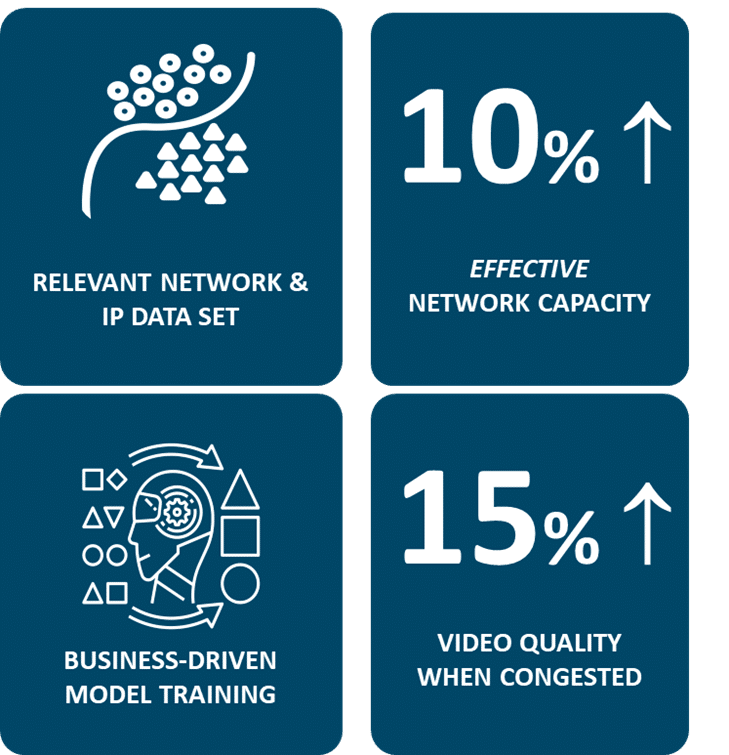Model, Implement, Act & Repeat
AI & Optimization Boost Capacity Even When Congested
The unique thing about mobile data networks is just that – mobility; predicting where users will be and their data demands is part science and part art. It is a testament to how networks are run today that the natural expectation of users is fast access from anywhere. They do not tolerate delay – and they tend to blame the network operator when this happens (Enea survey results show most users will abandon video stream after 6s of buffering and they will perceive the network as bad quality)[1].
This can happen on isolated basis (remote location, difficult geographic conditions) but also on a collected basis – i.e. too many people in the same area accessing data – this is commonly called congestion. On the internet side some people may say the response is to ‘provide more radio’ but that takes time and will not handle unpredictable congestion. 
The radio network is a complex set of entities – with radio signals being coordinated in first instance through a unit called the eNodeB[2] (base station unit that handles wireless communication). A large number of radio cells may be connected to an eNodeB, which can support thousands of users. Additional radio network congestion monitoring component (RCAF)[2] can be added to detect and isolate congestion (can occur when an eNodeB is running out of physical resource blocks to support radio access). Insertion of new radio components (or upgrading for integration to RCAF) will be costly and inevitably time consuming as network function changes always are across multiple vendors.
At Enea we think of the problem from a different perspective. We have become more reliant on our mobile devices on data access and not voice. As such monitoring the data access protocols and parameters, can provide insight into data flow issues indicative of congestion. Obviously a very large number of dropped packets in a protocol flow is usually indicative of a downstream fault. Congestion is harder to detect with a gradual increasing in protocol round trip time (in the case of TCP) or a gradual increase in the number of dropped packets in a user’s flow, or decrease in throughput for a user, are examples of parameters that can be continuously monitored.
In the Enea case a model can be built, over time that be trained to detect these conditions – without the use of overlay components and probes. Associating data congestion patterns with location is enough to model if a cell or eNodeB is tending toward a congested state, in real time.
As you may have guessed this is where the AI/Machine learning comes into play; modelling to detect these conditions, training to avoid false negatives, feedback loop for checking accuracy – provides the first key step in detecting network hotspots without expensive overlay probes and additional components [this is done on the Gi Path or 5G N6[2] interface]. As Enea we have been connecting the IP data traffic with standard radio data, to make a workable ML model that has proven a successful detection of congestion in live mobile networks. The model is trained to reduce as much as possible the likelihood to miss a congested cell.
The goal of this is to mitigate congestion and improve the user experience, so the next step is what action to take, as rolling out additional physical access will take time, so is there anything that can be achieved with the data itself?
Again, this is where Enea thinks differently. We can act on the data flows themselves by moderating & optimizing packet flows we can smooth the flow so that traffic is sent to eNodeB in a more regulated way – avoiding unnecessary collisions. In effect think of a large motorway with occasional congestion delays, we know that when we in the flow sometimes these events have no apparent cause (it is normally a flow effect of multiple vehicle’s break lights) [3]. If everyone drove more smoothly, we would all get to where we want to go without experiencing ‘stalling’.
The techniques of Enea’s traffic management optimize video streaming, which is the top contributor to data traffic in mobile networks (60-70% of the mobile data is video).
The results are clear, without additional physical radio infrastructure the effective capacity of the network can be boosted by +10%[4]. It can also boost the average quality of video streaming received by users by +15%[4], i.e. instead of slowing all video streams down (as would happen if no solution was in place), selective action is taken on the higher end (HD) video streams.
The action is selective (on congestion detection) and real time, it can be tuned to preferred level of the mobile operator. Automatically disabling when the congestion is eased. This is a practical use of AI/Machine learning for selective intervention only when essential, capable of working with 4G and 5G. It has been tested with tier#1 operators already.
For more information on this contact the Enea team @ https://info.enea.com/contact-us
Enea Traffic Management Solutions @ https://www.enea.com/solutions/traffic-management/ran-congestion-management/
This article also appears in the fast mode
References:
[1] Results from Enea Mobile Video Council and Video Index reports
RCAF – Radio Congestion Awareness Function
[3] https://phys.org/news/2007-12-traffic-mystery-mathematicians.html





